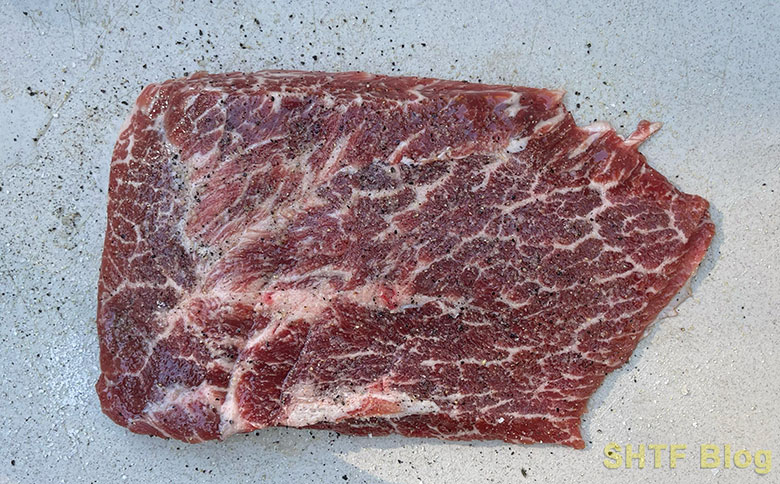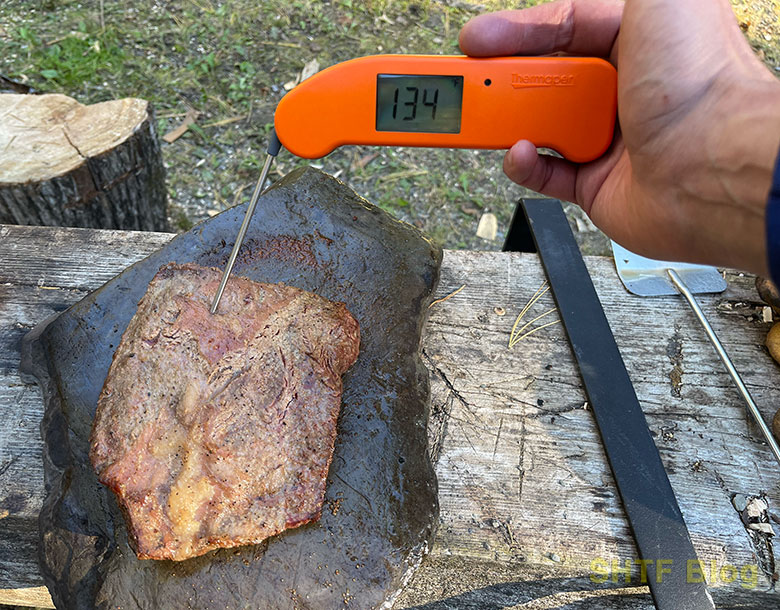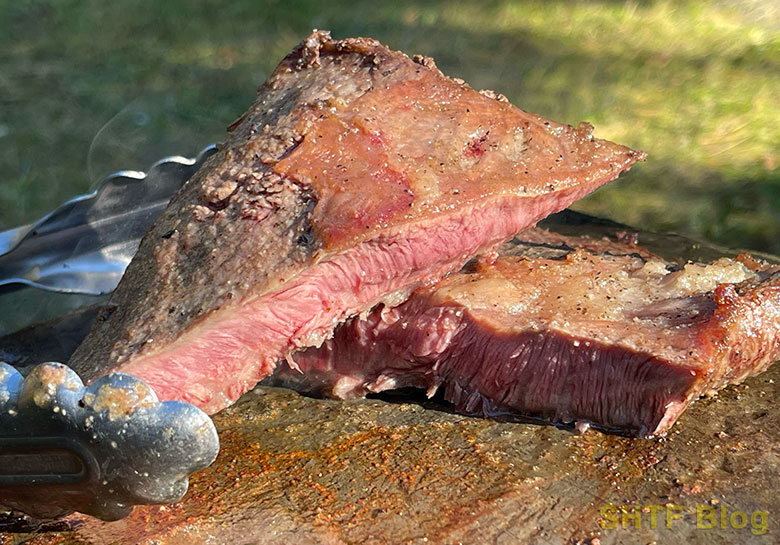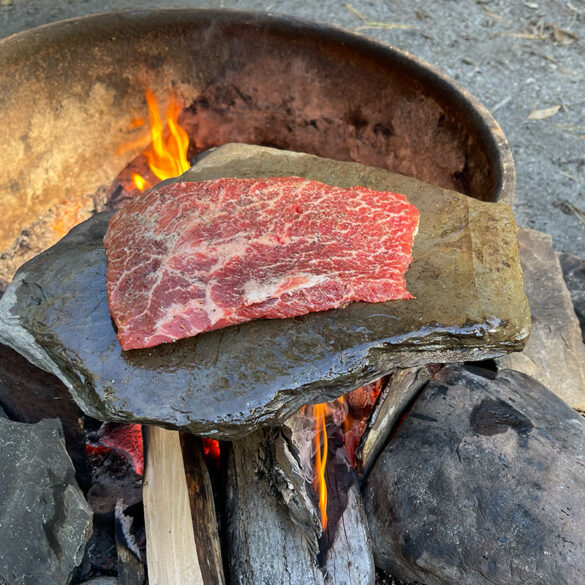
Cooking over a campfire is fun. It requires more attention, skill, and practice than cooking in a kitchen or even a grill. If you have some patience and a basic campfire cooking kit you can get started. But what about trying something more out of the norm? What about cooking steak on a stone?
Sounds caveman-like, no? It’s something from the “stone” age, like cooking “primal” rib.
This is a great way to push your outdoor cooking skills to the next level. It will be a conversation starter among friends. For the prepper and bushcraft enthusiast, knowing how to cook steak on a stone will add another layer of outdoor skills and self-reliance. Who needs a cast iron skillet when there are flat stones all around?
How I Cooked Steak on a Stone
TLDR: Find a flat stone, clean it, prep your steak, wait patiently for the fire to heat the stone, and cook it while using a meat thermometer to determine when it’s done.
I’d seen this cooking strategy before on bushcraft videos, TikTok, etc., but it seemed too advanced at the time for my still-developing outdoor cooking skills. The reality is that using a stone to cook steak is surprisingly simple.
The biggest secret to cooking steak on a stone, as with all outdoor cooking, is patience. It’s not like firing up a grill and waiting a few minutes to throw your steaks down. You want to plan ahead at least 30 minutes, but more on that in a moment.
I Found a Flat Stone (and cleaned it)
This first thing I had to do was find a flat stone. I was way up in the north woods of Maine when I was doing this, so it wasn’t terribly difficult to locate options. In fact, I brought 3 or 4 back to camp to see which would work best. I had a few rocks from a riverbed and a few from a pile of slate.
I made a decision on which stone to use based on which would balance over the open area of the fire ring at our site. Both a river stone balanced as did a piece of slate. I took both to the river and wiped them clean.

Depending on your campfire situation, you can balance your flat rock on two other stones, some bricks, or even on a grill grate if that works for you.
I began by heating both stones up as a test. The slate got very hot very fast as it was thinner. I decided not to use slate, however, because I was afraid extended exposure to the heat might cause the slate to break apart, sending my steak into the fire and ash.
I Built a Small Fire
You can see in the picture above that I created a small fire. I actually started the fire in the fire ring itself and moved it under the stone after I had established some hot coals. Unless you’re using a charcoal chimney to speed things up, this is the most time consuming part of the process. The fire needs to burn for a bit to establish the coals that will do most of the heating, and even then you’ll still have to tend it by adding small sticks as you go.
I Prepped the Steak (and the stone)
I bought a cheap steak for this effort, not interested in wasting good money on a ribeye. I expected it to turn out tough (it didn’t). Using a thinner cut is recommended. This is a more challenging process for any steak 1″ or thicker.

While the fire was building I lathered the steak in olive oil and seasoned it with my super secret survival seasoning (equal parts Kosher salt, fresh ground pepper, and garlic powder). I also poured a bit of olive oil onto the stone. Do this carefully as any run off oil will drip into the fire causing a flareup.
I Cooked that Bad Boy Like a Boss
I was hungry and itching to eat, so I set the steak on the stone too soon (a few times). I promptly pulled it off, stoked the fire a bit more, and waited longer until I eventually got the “sizzle” sounds I was waiting for.
Cooking steak on a stone is not an exact science. You will not be able to turn a dial and set the flame intensity. You have to adapt to the steak, the stone, and the fire. This is where a meat thermometer becomes your friend, it’s the surest way to get your steak cooked how you like it. I used my Thermapen One, which is about the highest-end food thermometer you can buy. I use it enough to justify the expense.

Remember that a steak continues to cook after it’s removed from the flame. So, if your ideal internal steak temp is 135 degrees (or whatever), you want to remove it before it reaches that temp. It will continue to climb after it’s removed from the heat.
Lavatools makes a knockoff version of the Thermapen One. It cost quite a bit less and has strong reviews, so that’s an option for the person who doesn’t need or desire the higher-end Thermapen One.
- 🥇 Voted #𝟭 𝗺𝗶𝗱-𝗽𝗿𝗶𝗰𝗲𝗱 𝘁𝗵𝗲𝗿𝗺𝗼𝗺𝗲𝘁𝗲𝗿 by America's Test Kitchen and Wirecutter and #𝟭 𝘁𝗵𝗲𝗿𝗺𝗼𝗺𝗲𝘁𝗲𝗿 by NBC News. Featured in major publications: WIRED, GQ, Gear Patrol, Men's Health, Bloomberg, Bon Appétit, New York Magazine, Business Insider, and much more.
- 𝗨𝗹𝘁𝗿𝗮-𝗳𝗮𝘀𝘁 𝟭-𝟮 𝘀𝗲𝗰𝗼𝗻𝗱 𝗿𝗲𝗮𝗱𝗼𝘂𝘁𝘀 thanks to a proprietary high-performance Japanese sensor, making Javelin PRO Duo one of the most popular cooking and grilling accessories out there.
- 𝗦𝘂𝗽𝗲𝗿𝗯 𝗮𝗰𝗰𝘂𝗿𝗮𝗰𝘆 𝗼𝗳 ±𝟬.𝟱°𝗙 achievable via laboratory calibration. Javelin PRO Duo is an instrument-grade digital cooking thermometer designed to take the guesswork out of cooking.
- A 𝗹𝗮𝗿𝗴𝗲 𝟮" 𝟭𝟴𝟬° 𝗮𝘂𝘁𝗼-𝗿𝗼𝘁𝗮𝘁𝗶𝗻𝗴 𝗮𝗻𝗱 𝗺𝗼𝘁𝗶𝗼𝗻-𝗮𝗰𝘁𝗶𝘃𝗮𝘁𝗲𝗱 𝗯𝗮𝗰𝗸𝗹𝗶𝘁 𝗱𝗶𝘀𝗽𝗹𝗮𝘆 makes Javelin PRO Duo instant read thermometer well-suited for glove-wearers, awkward angles, and left-handed users.
- 𝗜𝗣𝟲𝟱-𝗿𝗮𝘁𝗲𝗱 𝘄𝗮𝘁𝗲𝗿 𝗿𝗲𝘀𝗶𝘀𝘁𝗮𝗻𝘁 construction shields the Javelin PRO Duo digital meat thermometer against spills, kitchen mishaps, and the daily rigors of both home and professional kitchens.
I Ate that Steak
I was surprised how good the steak was, to be honest. For a lower quality cut cooked on a stone, it was hard to imagine getting any better on a grill. Given the conditions and limitations, it was perfect.

Recipe
Find a flat stone and wash it clean. Start a fire and and place hot coals under the stone to begin heating it. Heat times will vary depending on the flames, coals, and thickness of the stone. Rub olive oil over the steak and season it with the seasoning of your choice or use equal parts Kosher salt, fresh ground pepper, and garlic powder. When stone is hot enough, pour olive oil on the stone (beware of oil running off stone and into the fire creating larger flames). Fry steak on the stone for 6-7 minutes, but be prepared to monitor the steak as cook times will vary. Flip and cook the other side until the steak reaches the desired internal temperature. Wait 10-15 minutes. Serve and enjoy. 
Ingredients
Instructions
Summary
Cooking a steak, or anything, on a stone is fun. You can impress your friends with your caveman cooking skills and you’ll even surprise yourself once you taste it. It’s that simple!
Have you cooked steak on a stone? Let me know in the comments section. I want to know how yours came out.

4 comments
Up here in Maine the Boy Scouts run a high adventure base and at the end of the season they have what they call a “Moose Feed”.
They cook their steaks directly on the coals of Maple wood after it has burned down.
There is very little ash sticking to the meat, and they have a butter wash that they dip it in to get it clean.
Yummy!
Yup, it’s called “dirty cooking” or “caveman cooking.” Get the coals white hot and there is little ash. I’m in Maine, too!
From your article: “I had a few rocks from a riverbed”
I would be extremely cautious about using rocks from a wet stream bed. The result of heating water permeated rock can be very “dynamic.” The more porous the rock, the more likely the result.
you might note just for your safety that any stones found may have moisture in the cracks , and more so if found and utilized near a waterway ,because while heating stones they can explode from trapped moisture inside the stone .this explosive expansion has resulted in many injuries just from setting a fire ring ,and though anecdotally some deaths have been mentioned from the explosions…..not saying don’t just stand back and pay attention while heating to cooking temp. it’s great for bacon btw eggs are a bitch though ,poach ’em